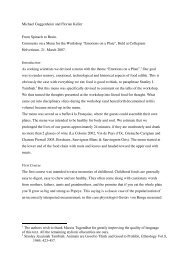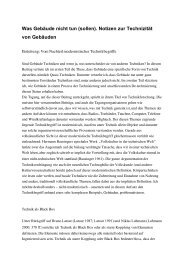The Laws of Foreign Buildings: Flat Roofs and Minarets - Michael ...
The Laws of Foreign Buildings: Flat Roofs and Minarets - Michael ...
The Laws of Foreign Buildings: Flat Roofs and Minarets - Michael ...
You also want an ePaper? Increase the reach of your titles
YUMPU automatically turns print PDFs into web optimized ePapers that Google loves.
Guggenheim 5<br />
do so, it is very difficult to say how the material <strong>and</strong> semiotic aspects <strong>of</strong> buildings relate<br />
to the interactions taking place inside <strong>of</strong> them.<br />
Sometimes buildings are indeed technologies that structure, enable or even enforce<br />
practices, <strong>and</strong> sometimes they are not. Because <strong>of</strong> this feature I call buildings quasitechnologies,<br />
thereby indicating that buildings in some instances work as technologies<br />
<strong>and</strong> in others do not (Guggenheim, 2009, 2010). Different from other technologies, it<br />
is very difficult to attribute technological powers or even failings to buildings. For example,<br />
it is easy to determine whether a CD-player works or not. However, it is very difficult<br />
to say whether a bank works or fails.<br />
From this theoretical premise follows an empirical imperative: We should not assume<br />
a sociological position <strong>and</strong> criticize actors for not underst<strong>and</strong>ing that buildings are not<br />
technologies. Neither should we assume a technological position <strong>and</strong> criticize actors for<br />
assuming that buildings are defined by interactions. Instead, I follow empirically how<br />
various actors define buildings as symbolic, technological or defined through interactions<br />
<strong>and</strong> explain why they do so. I use the following terms to describe the respective<br />
arguments <strong>of</strong> actors. When an actors tries to prove the technological properties <strong>of</strong> a<br />
building, I call this technologizing. An instance would be when somebody says, ‘Only<br />
with a teller window a bank works as a bank’. When an actor tries to prove the semiotic<br />
properties <strong>of</strong> a building I call this ‘mediatizing’. This would happen when an actor says,<br />
‘Mirror glass windows clearly indicate that this is a bank <strong>and</strong> this is sufficient to make it<br />
work’. When an actor tries to prove the interactional qualities <strong>of</strong> building I call this<br />
‘socializing’. An example for this would be when somebody says, ‘As long as people<br />
exchange money in this building, it is a bank’. Finally, I call ‘materializing’ a procedure<br />
that denies that a building is technical, <strong>and</strong> reduces it to its mere materiality. This is for<br />
example the case, when somebody might say: ‘This glass division wall is just a glass<br />
wall. It does not facilitate the exchange <strong>of</strong> money’. Each <strong>of</strong> these statements may be ‘proven’<br />
with a range <strong>of</strong> material <strong>and</strong> interactional elements that are part <strong>of</strong> the respective<br />
processes. As follows from my theoretical position, none <strong>of</strong> these positions hold up to<br />
scrutiny, <strong>and</strong> none <strong>of</strong> them can be proven in any scientific or legal sense.<br />
<strong>The</strong> fact that buildings are quasi-technologies is central to underst<strong>and</strong> legal conflicts<br />
about building codes <strong>and</strong> zoning. This is so, because the legal definition <strong>of</strong> a zone relates<br />
areas <strong>of</strong> l<strong>and</strong> classified as a specific zone to a use taking place on this l<strong>and</strong> <strong>and</strong> the buildings<br />
situated on it. Swiss federal law says: ‘zoning plans regulate the admissible uses <strong>of</strong><br />
the l<strong>and</strong>’ (Schweizerische Eidgenossenschaft, 1979, Art. 14, emphasis added): <strong>The</strong> regulation<br />
is defined as concerning the uses, not the buildings. One could infer that the law<br />
does not hold a technological view <strong>of</strong> buildings! In theory, the definitions <strong>of</strong> specific<br />
zones in zoning law only relate to uses <strong>and</strong> not to building forms, because it is assumed<br />
that the forms do not enforce uses <strong>and</strong> therefore the latter are decisive for the classification<br />
<strong>of</strong> a building. However, as we will see over <strong>and</strong> over, this is only partially true. <strong>The</strong><br />
confusion already starts at the level <strong>of</strong> written law when it defines specific zones: For<br />
example, the building code <strong>of</strong> the Canton <strong>of</strong> Zürich, in §60 reserves a zone for ‘public<br />
buildings’ – <strong>and</strong> not public uses (Baudirektion des Kantons Zürich, 2005, §60, p.15,<br />
emphasis added). <strong>The</strong> switch to a technological theory <strong>of</strong> buildings happens without<br />
being noticed, already on the level <strong>of</strong> the written law, <strong>and</strong> as I will show, it continues<br />
in jurisdiction.<br />
5







